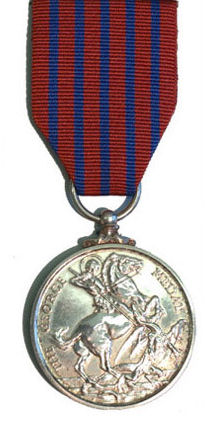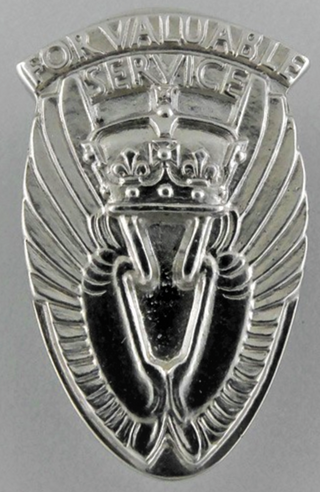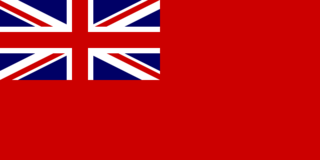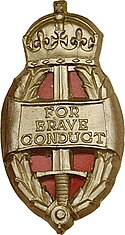The George Cross (GC) is the highest award bestowed by the British government for non-operational gallantry or gallantry not in the presence of an enemy. In the British honours system, the George Cross, since its introduction in 1940, has been equal in stature to the Victoria Cross, the highest military gallantry award. It is awarded "for acts of the greatest heroism or for most conspicuous courage in circumstance of extreme danger", not in the presence of the enemy, to members of the British armed forces and to British civilians. Posthumous awards have been allowed since it was instituted. It was previously awarded to residents of Commonwealth countries, most of which have since established their own honours systems and no longer recommend British honours. It may be awarded to a person of any military rank in any service and to civilians including police, emergency services and merchant seamen. Many of the awards have been personally presented by the British monarch to recipients or, in the case of posthumous awards, to next of kin. The investitures are usually held at Buckingham Palace.

The George Medal (GM), instituted on 24 September 1940 by King George VI, is a decoration of the United Kingdom and Commonwealth, awarded for gallantry, typically by civilians, or in circumstances where military honours are not appropriate.

The Distinguished Conduct Medal was a decoration established in 1854 by Queen Victoria for gallantry in the field by other ranks of the British Army. It is the oldest British award for gallantry and was a second level military decoration, ranking below the Victoria Cross, until it was discontinued in 1993 when it was replaced by the Conspicuous Gallantry Cross. The medal was also awarded to non-commissioned military personnel of other Commonwealth Dominions and Colonies.

The Distinguished Service Cross (DSC) is a third-level military decoration awarded to officers; and, since 1993, ratings and other ranks of the British Armed Forces, Royal Fleet Auxiliary and the British Merchant Navy have been included. Additionally, the award was formerly awarded to members of other Commonwealth countries.

The Distinguished Service Medal (DSM) was a military decoration awarded until 1993 to personnel of the Royal Navy and members of the other services, and formerly to personnel of other Commonwealth countries, up to and including the rank of Chief Petty Officer, for bravery and resourcefulness on active service at sea.
To be mentioned in dispatches describes a member of the armed forces whose name appears in an official report written by a superior officer and sent to the high command, in which their gallant or meritorious action in the face of the enemy is described.

The Conspicuous Gallantry Medal (CGM) was, until 1993, a British military decoration for gallantry in action for petty officers and seamen of the Royal Navy, including Warrant Officers and other ranks of the Royal Marines. It was formerly awarded to personnel of other Commonwealth countries. In 1943 a Royal Air Force version was created for conspicuous gallantry in action against the enemy in the air.

The British Empire Medal is a British and Commonwealth award for meritorious civil or military service worthy of recognition by the Crown. The current honour was created in 1922 to replace the original medal, which had been established in 1917 as part of the Order of the British Empire.
The Union of South Africa King's Medal for Bravery, Gold was the highest South African civilian decoration during the period between 1910 and 1961, when the country was a constitutional monarchy in the British Commonwealth. The medal was instituted by King George VI on 23 June 1939.

The King's Gallantry Medal (KGM), formerly the Queen's Gallantry Medal (QGM), is a United Kingdom decoration awarded for exemplary acts of bravery where the services were not so outstanding as to merit the George Medal, but above the level required for the King's Commendation for Bravery.

The King's Commendation for Bravery and the King's Commendation for Bravery in the Air are United Kingdom awards, open to both military personnel and civilians. They were established in 1994, when the award of the Queen's Commendation for Brave Conduct and the Queen's Commendation for Valuable Service in the Air were discontinued.

The New Zealand Gallantry Medal (NZGM) is the fourth level military decoration of the New Zealand armed forces.

The New Zealand Bravery Medal (NZBM) is the fourth-level civil decoration of New Zealand.

The King's Commendation for Valuable Service is a British military award for meritorious service in an operational theatre. It was established in 1994, when the award of the Queen's Commendation for Brave Conduct and the Queen's Commendation for Valuable Service in the Air were discontinued.

The Queen's Commendation for Valuable Service in the Air, formerly the King's Commendation for Valuable Service in the Air, was a merit award for flying service awarded by the United Kingdom between 1942 and 1994. It was replaced by the Queen’s Commendation for Bravery in the Air and the Queen's Commendation for Valuable Service.

The Sea Gallantry Medal (SGM), is a United Kingdom award for civil gallantry at sea.
Gordon Love Bastian, was an engineering officer in the British Merchant Navy who was awarded the Albert Medal for risking his own life to save other members of the crew of SS Empire Bowman after it was torpedoed on 31 March 1943. In 1971, living recipients of the Albert Medal and Edward Medal were instructed to return their medal and were instead issued with the George Cross, the highest decoration for gallantry awarded to civilians or to military personnel for actions "not in the face of the enemy" in the United Kingdom and Commonwealth

Merchant seamen crewed the ships of the British Merchant Navy which kept the United Kingdom supplied with raw materials, arms, ammunition, fuel, food and all of the necessities of a nation at war throughout World War II — literally enabling the country to defend itself. In doing this, they sustained a considerably greater casualty rate than almost every other branch of the armed services and suffered great hardship. Seamen were aged from fourteen through to their late seventies.



















